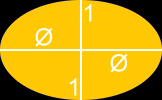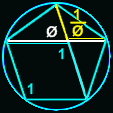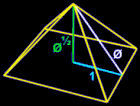The following is an article that I found about Golden Mean-Pi Product
The Pi-Phi Product and its derivation through limits
The product of phi and pi,
1.618033988… X 3.141592654…, or 5.083203692,
is found in golden geometries:
| Golden Circle | Golden Ellipse |
 |  |
| Circumference = p * Φ | Area = p * Φ |
Ed Oberg and Jay A. Johnson have developed a unique expression for the pi-phi product (pΦ) as a function of the number 2 and an expression they call “The Biwabik Sum,”a function of phi, the set of all odd numbers and the set of all Fibonacci numbers, as follows:
| p Phi = 2² {1 | + [ (2/3) / (F1+F2 Phi) + (1/5) / (F3+F4 Phi) – (1/7) / (F5+F6 Phi) ] |
| – [ (2/9) / (F7+F8 Phi) + (1/11) / (F9+F10 Phi) – (1/13) / (F11+F12 Phi) ] | |
| + [ (2/15) / (F13+F14 Phi) + (1/17) / (F15+F16 Phi) – (1/19) / (F17+F18 Phi) ] | |
| – … } | |
| = 5.083203692…. |
This relationship was derived after Oberg noticed an interesting relationship between pi and phi while contemplating geometric questions related to the location of the King and Queen’s burial chambers in the Great Pyramid, Cheops, of Giza, Egypt, the design of which is based on phi.You can access the complete paper published by Ed Oberg and Jay A. Johnson, The Pi-Phi Product, in Word, or the Pi-Phi Product in Excel to see their formulation illustrated numerically.
Trigonometric functions relating phi (Φ) and pi (Π)
Divide a 360° circle into 5 sections of 72° each and you get the five points of a pentagon, whose dimensions are all based on phi relationships.

Accordingly, it shouldn’t be too surprising that phi, pi and 5 (a Fibonacci number) can be related through trigonometry:
Or, a much simpler way involving, contributed by Dale Lohr:
Pi = 5 arccos (.5 Phi)
Note: The angle of .5 Phi is 36 degrees, of which there are 10 in a circle or 5 of in pi radians.
Note: Above formulas expressed in radians, not degrees
Alex Williams, MD, points out that you can use the Phi and Fives relationship to express pi as follows:
5arccos((((5^(0.5))*0.5)+0.5)*0.5) = pi
Robert Everest discovered that you can express Phi as a function of Pi and the numbers 1, 2, 3 and 5 of the Fibonacci series:
Phi = 1 – 2 cos ( 3 Pi / 5)
Pi and Phi in the Great Pyramid of Egypt
Another interesting relationship between Pi and Phi is related to the geometry of the Great Pyramid of Giza. This relationship connects dimensions of the Great Pyramid to both Pi and Phi, but it is not known with certainty whether this was an intentional aspect of its design, whether its design was based on Pi or Phi but not both, or whether it is a simple coincidence. It relates to the fact that 4 divided by square root of phi is almost exactly equal to Pi:
The square root of Phi (1.6180339887…) = 1.2720196495…
4 divided by 1.2720196495… = 3.14460551103…
Pi = 3.14159265359…
The difference of these two numbers is less than a 10th of a percent.
See the Phi, Pi and the Great Pyramid page for more details.
https://www.goldennumber.net/pi-phi-fibonacci/
I investigated the angle based on Golden Mean-Pi Product
360° divided by 5.083203692 = 70.82147830640189
70°49'16'' is the Golden Mean-Pi Product's angle.
Looking for a recent exact Moon-Uranus Golden Mean-Pi Product transit in Solar Fire,
I found an exact Moon-Uranus Golden Mean-Pi Product Aspect for March 29, 2022 at 10:53:08 PM here in Tacoma, Washington.
According to Sirius astrology program's harmonic grid,
Golden Mean-Pi Product Aspect has the following corresponding Harmonic Aspects with orb (deviation from being exact)
12/61 - 0 min (with strength of 99%)
Golden Mean-Pi Product Aspect angle seems to be the 12/61 Aspect.
Golden Mean-Pi Product Aspect has the following corresponding Harmonic Aspects with the orb of the conjunction in the particular harmonic:
12/61 - 5 min
The proportionate orb for the harmonic aspects based on 15 degree orb for conjunction:
12/61 - 15 min
note that it's also a Quintile which is a Fibonacci Harmonic Aspect with it being The 1/5 aspect at 60% strength


.png)


No comments:
Post a Comment